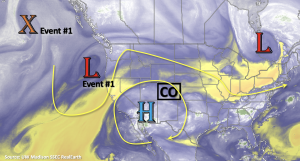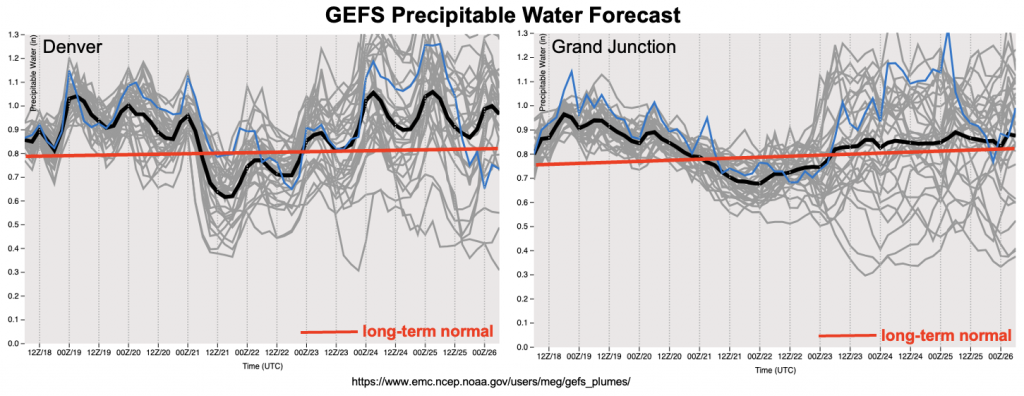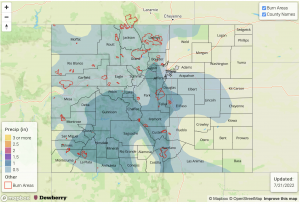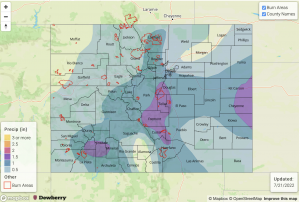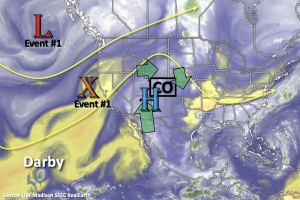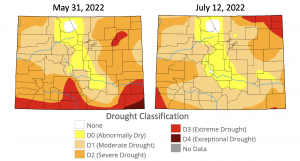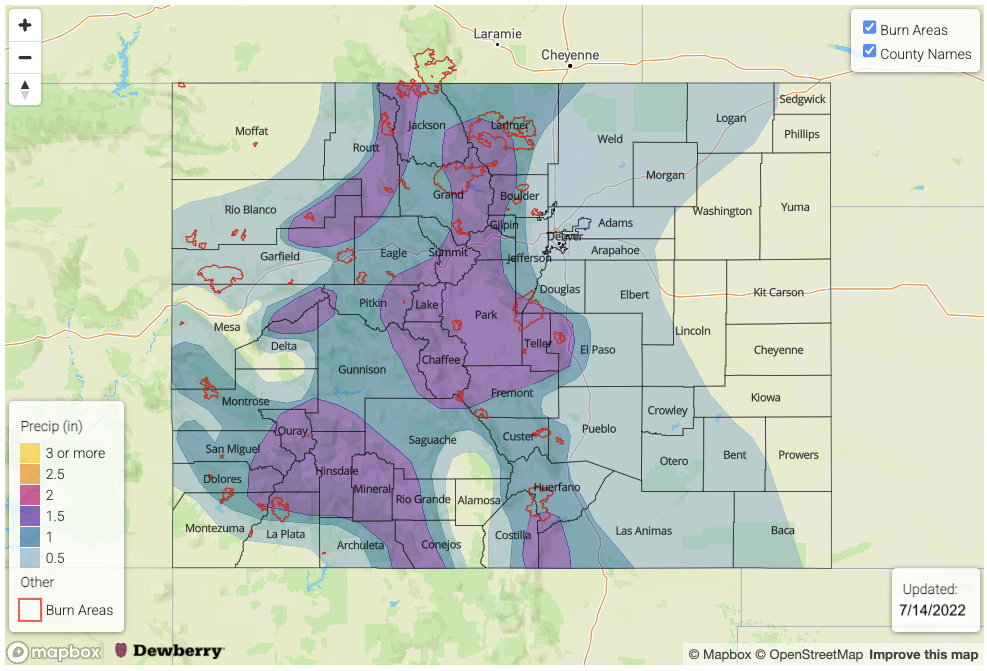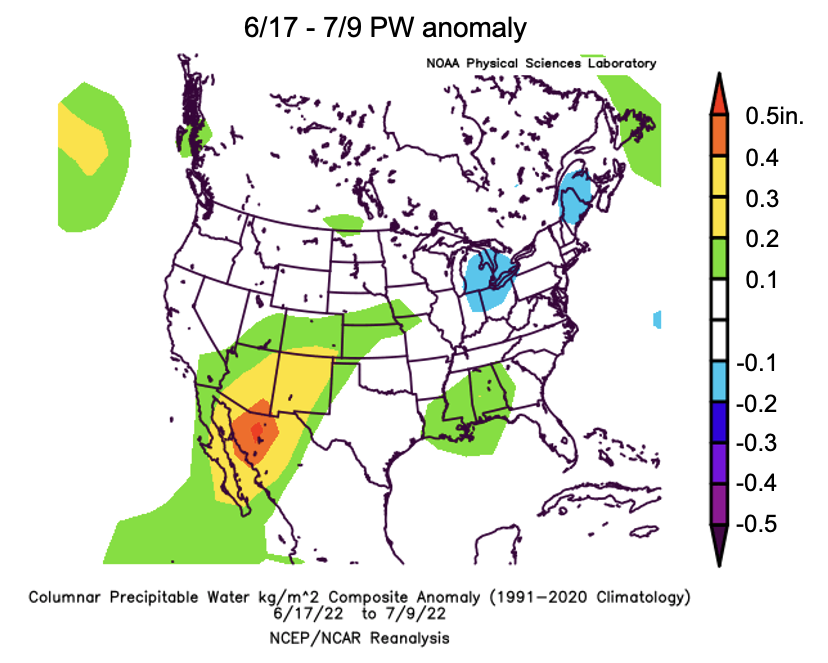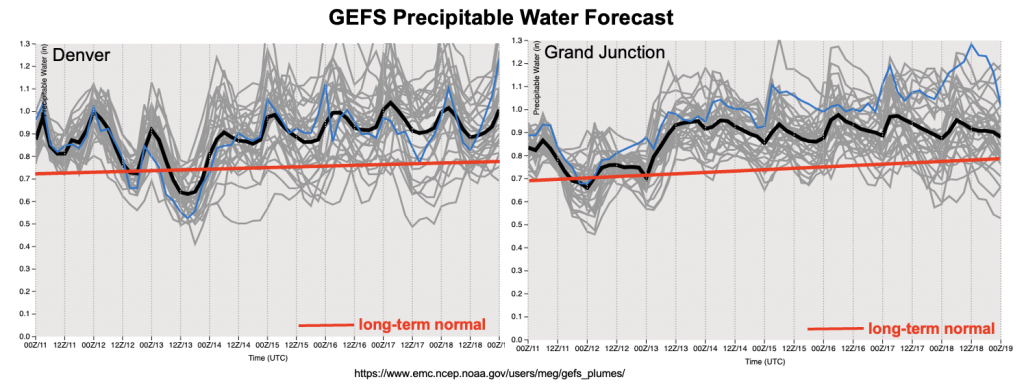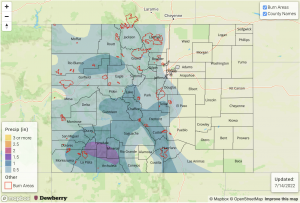Issue Date: Thursday, July 21st, 2022
Issue Time: 2:20PM MDT
Valid Dates: 7/22 – 8/5
Before we get going with today’s FTO, here’s a quick look at the estimated number of precipitation days across the state since May 1st. For reference, it has been 81 days or slightly over halfway through the FTB forecast season. It has been very active along the Front Range and Central Mountains, especially near the Continental Divide. The Grand Valley and Northwest Slope have also been more active than last year, but more limited precipitation days were noted over the elevated ridges and eastern plains. Overall, it has been a long and active monsoon season for the higher terrains, and it sure isn’t going to stop for this next FTO period. This is right on time with the peak in climatological PW for the year.
Looking at the water vapor imagery below, the High is currently over Arizona with an incoming Low off the west coast. As the Low and subsequent shortwaves move east over the next few days (Event #1), they will start to break down the High before a ridge rebuilds over the Pacific (Event #2). A second High should then develop to our southeast, which will help pull a subtropical moisture plume northward on its west side. As this moisture meets disturbances moving through the northwesterly flow, a very active rainfall pattern is anticipated. Finally, by the end of next week, the High should begin to reestablish itself over the Four Corners region. This should keep rainfall in the forecast for the foreseeable future.
As far as the flood threat, after tomorrow, it becomes quite elevated with PW at or above the long-term average through Tuesday (west) and Thursday (east). A High flood threat has been issued for Sunday through Tuesday with a peak in rainfall activity (intensity and coverage) anticipated on Sunday. An Elevated threat has then been issued for the back end of Event #2, but it is possible that this could be upgraded in Monday’s FTO. At that time, there should be better model consensus about where the moisture plume will set up, but it is likely that the heavy rainfall threat will continue over eastern Colorado. The end of Event #2 should be the most favorable pattern for widespread rainfall over the eastern plains.
One other weather factor for the end of this week will be the continuation of heat on Friday and Saturday. A Heat Advisory has been issued for the Grand Valley tomorrow with a shot at breaking the Grand Junction daily record. A high temperature of 104°F has been forecast with upper 90Fs forecast across the I-25 Corridor. On Saturday, there will be another shot at breaking the Grand Junction daily record as well as the daily records over Alamosa and Pueblo. High temperatures over the eastern plains should reach between 100-105°F, so be sure to hydrate over the next couple of days. A cooldown is anticipated on Sunday with a shot at much cooler temperatures for eastern Colorado on Wednesday behind a strong cold front.
Event #1: Friday – Sunday (7/22 – 7/24)
There is an increasing threat for this event with a High flood threat issued on Sunday as an abundance of moisture and mid-level dynamics combine for widespread, heavy rainfall.
More garden variety storms are forecast tomorrow with residual moisture over the area. Best chance for isolated to widely scattered storms will again be across the high terrains favoring areas south with some limited activity possible over the far eastern plains. There should be an uptick in moisture and dynamics on Saturday with scattered storms forecast over the mountains. With steering flows increasing across the northern portion of the state, the flood threat should be limited to the burn areas for this area. Over the central and southern high terrains slower steering flows and some training storms could produce isolated heavy rainfall with max 1-hour rain rates up to 1.1 inches possible. Sunday is the peak in rainfall intensity and coverage for this event with activity ramping up due to a passing shortwave and westerly steering flows spilling storms into the adjacent eastern plains. Max 1-hour rain rates up to 1.5 inches (west) and 2.25 inches (east) will be possible along with a couple stronger thunderstorms. A HIGH flood threat has been issued for this day as a Moderate threat or higher will likely be issued in the daily FTB.
Event #2: Monday – Thursday (7/25 – 7/28)
High flood threat as moisture streams in from the south with embedded disturbances in the mid-levels.
Heavy rainfall chances continue at the beginning of next week starting out over the southern high terrains. Best chance for heavy rainfall on Monday will be over southwest Colorado, but ongoing rainfall and cloud cover may help to limit the flood threat over the same area on Tuesday. Storm activity looks to increase over eastern Colorado on Wednesday and Thursday with some heavy rainfall forecast for the elevated ridges and Southeast Plains. Hopefully a storm can dip into the Northeast Plains off the Cheyenne Ridge during this period, with this most likely to occur on Wednesday.
Event #3: Friday – Sunday (7/29 – 7/31)
No Apparent flood threat as High sets back up over the Four Corners region.
A lot of changes are anticipated for Event #3, since it is over a week out before it begins. It looks like the center of the High will set back up over the Four Corners region, which could help produce a rainfall pattern similar to this week. Of course, minor details in the location of the High can be favorable or unfavorable regarding moisture over the state. Likely this will be a mountain rainfall event with minimal spillover into the adjacent eastern plains. Check back in on Monday when the FTO will be updated again.


